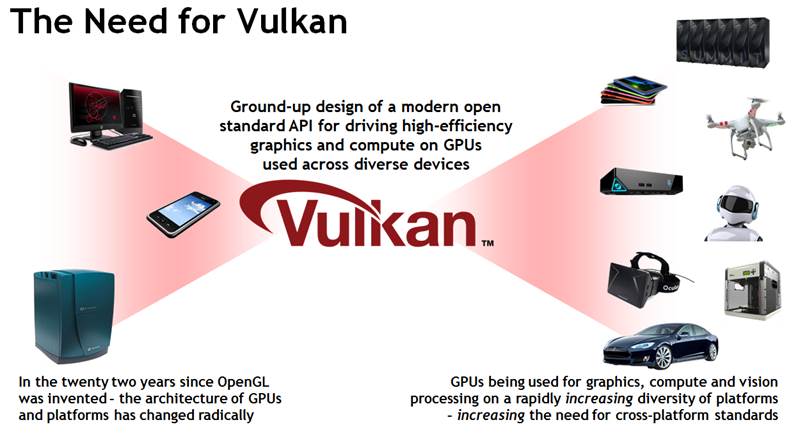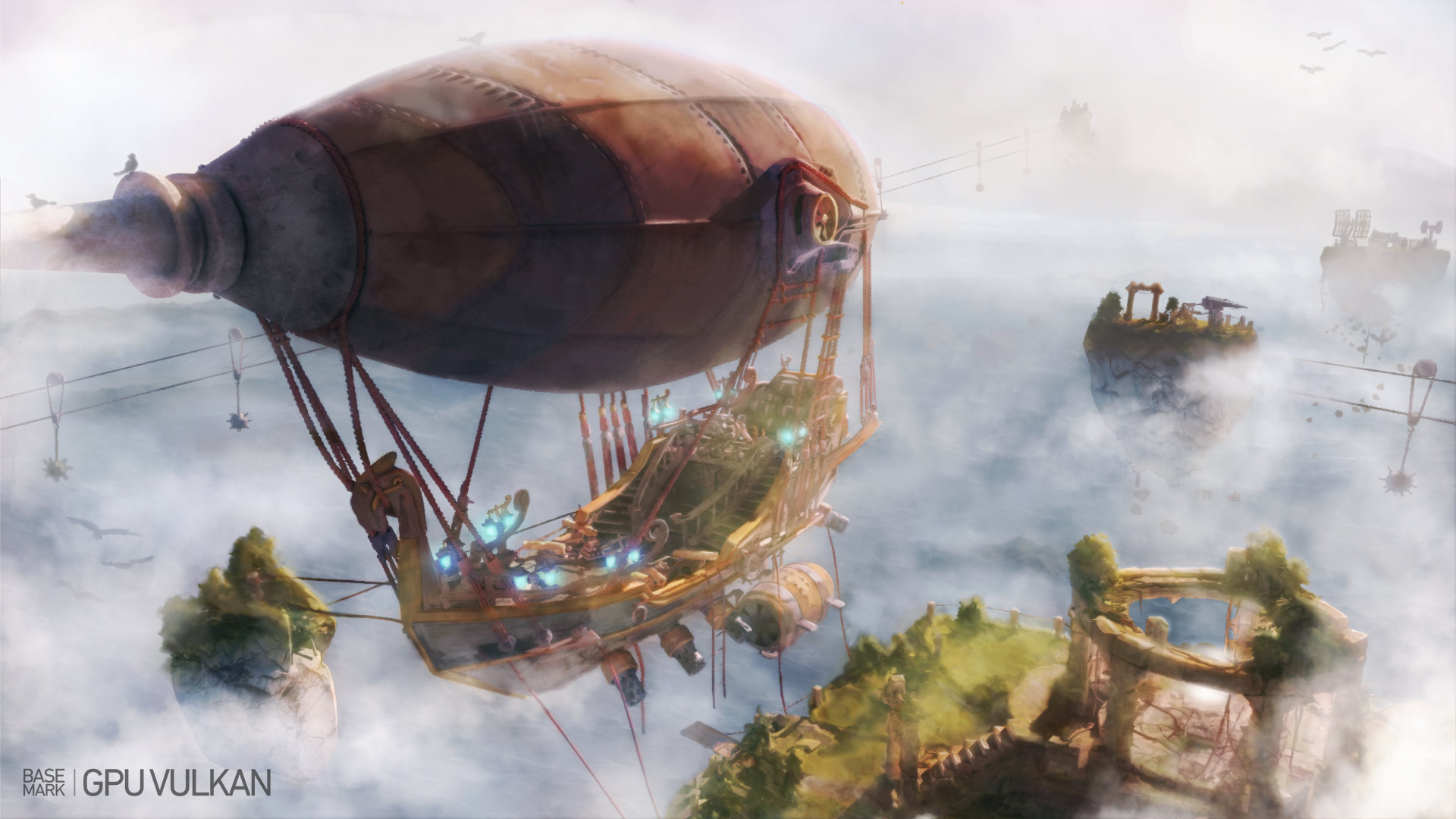Khronos Group Delays Vulkan, Pending Legal Review
The Khronos group announced that it would not be making its end-of-year target to have Vulkan wrapped up.
Originally, the Khronos group aimed to have its new Vulkan API wrapped up and released by the end of the year. Alas, that target will not be met.
The group informed us that the Vulkan API’s specification is complete, it still needs a couple of final touch ups and must make its way through legal review. Khronos did not give a new target deadline, but it shouldn’t take long.
The Vulkan API is the successor to OpenGL. In its early stages it was called GLNext, but that name has been scrapped. The API is built to offer lower-level access to the graphics hardware, much like AMD’s Mantle did originally and as DirectX 12 does today.
Low-level access to the hardware basically means that instead of relying on existing higher-level access layers, developers are able to access the graphics hardware more directly than before. This does make programming a little more difficult, but some of the developers we talked to at trade shows and for interviews indicated that they much prefer lower-level access, as it enables them to work the way they want to, rather than the way that the API makers think they want to.
On the consumer side, it’s also relevant: The removal of access layers means less overhead, meaning that games run better than before. With VR around the corner, we also need as much performance as we can get, so these APIs are all arriving right on cue.
“Vulkan will set the foundation for graphics and compute APIs for years to come and so Khronos is taking the time needed to do this right – and the Vulkan 1.0 release is near!” Khronos stated.
Various partners are already preparing their support for Vulkan, too. Johan Andersson from EA tweeted that the Frostbite engine would be supported on some platforms, and Gabe Newell from Valve also said that his team would be ensuring support. Many other developers have announced support, too. Google even announced that it would be using it in Android.
Get Tom's Hardware's best news and in-depth reviews, straight to your inbox.
DirectX 12 will likely remain the dominant graphics API for the time being, chances are that Vulkan support will be more widespread at some point than OpenGL ever achieved, thanks to gaming on Linux slowly becoming more popular.
Update, 12/22/2015, 11:07am PT: Fixed a typo.
Follow Niels Broekhuijsen @NBroekhuijsen. Follow us @tomshardware, on Facebook and on Google+.
Niels Broekhuijsen is a Contributing Writer for Tom's Hardware US. He reviews cases, water cooling and pc builds.
-
mitch074 DirectX 12 will remain the dominant API... On PC. Other stuff (like, say, Android) will use Vulkan instead. Next-gen cosoles (if not current ones - XBOne won't) will probably use it, too.Reply -
xHDx Well, this is Mantle with a few touch-ups was it not?Reply
That just got into around 10 games or so before they decided to transform it into this. No the wonder it didn't take long. -
beayn I find this funny because when 3d cards first game out, they *had* direct access to the GPU. Then developers claimed it took too long to create a game and loved having the new API's as they became available. Now they're like... API's restrict us too much, we want low level access.Reply -
bit_user Reply17165947 said:...
Article says:so these APIs are all arriving right on queue
I'm pretty sure that should be "... right on cue".
Also, having seen this news elsewhere, I was hoping the article would explain what's involved in a "legal review". Are they looking for patent violations, copyright infringements, ... ? This information would shed more light on the standardization process of bodies such as Kronos.
-
bit_user Reply
I think you're missing the point. This is a standard way to access low-level hardware, so that the same code will run on any GPU that supports it. Previous APIs, like Glide and the like were specific to a single vendor. So, developers would have to write code for each of the different vendors they wanted to run on. And the benefits of that vs. OpenGL or DirectX were small, because GPUs were vastly more primitive.17170634 said:I find this funny because when 3d cards first game out, they *had* direct access to the GPU. Then developers claimed it took too long to create a game and loved having the new API's as they became available. Now they're like... API's restrict us too much, we want low level access.
The closest analogy you'll find is perhaps that it's like reviving Direct3D's retained mode. But I suspect this is much lower-level. And retained mode fell into disfavor because many developers felt the performance benefits (which is the main thing it provided) weren't deemed worth the added API complexity. In contrast, Vulkan simplifies their code by giving them a lower-level interface, so that they don't have to contort their code to fit the model OpenGL provided. So, if you want to break the rendering model of OpenGL, then I think Vulkan both simplifies your code and improves performance.
-
bit_user Reply
I wonder... if Windows drivers for the 3 main GPU vendors (Nvidia, AMD, and Intel) all provide good Vulkan support, then why would a developer implement backends for both D3D 12 and Vulkan? The only argument I see is that MS will probably never support Vulkan on any XBoxes. Otherwise, it'd be simpler to use Vulkan everywhere.17168798 said:DirectX 12 will remain the dominant API... On PC. Other stuff (like, say, Android) will use Vulkan instead. Next-gen cosoles (if not current ones - XBOne won't) will probably use it, too.
-
N.Broekhuijsen @bit_user, I've emailed the Khronos group to ask what the legal review entails. I'll update the article when I hear back from them. :)Reply -
Simon Ayres ReplyWell, this is Mantle with a few touch-ups was it not?
That just got into around 10 games or so before they decided to transform it into this. No the wonder it didn't take long.
No it is not, you may be thinking of GPUOpen which, like Mantle, is an AMD initiative. This, as stated in the article, is The Khronos Group and is a replacement to their API OpenGL.
http://www.tomshardware.com/news/amd-gpuopen-open-source-development,30750.html -
JMW22 ReplyWow, so the Vulkan API renders 2D hand drawn pictures eh?
Neat.
No. That looks to me like an artist's rendition of the Unigine Heaven benchmark. They're implying that Vulkan will be good for performance, which is likely true. Vulkan will implement in an open, cross platform way what Direct X does for Windows.


